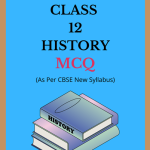NCERT Class 12 History MCQ Chapter 2 Kings, Farmers and Towns Solutions to each chapter is provided in the list so that you can easily browse through different chapters NCERT Class 12 History MCQ Chapter 2 Kings, Farmers and Towns and select need one. NCERT Class 12 History MCQ Chapter 2 Kings, Farmers and Towns Question Answers Download PDF. NCERT History MCQ Class 12 Solutions.
NCERT Class 12 History MCQ Chapter 2 Kings, Farmers and Towns
Also, you can read the NCERT book online in these sections Solutions by Expert Teachers as per Central Board of Secondary Education (CBSE) Book guidelines. CBSE Class 12 History MCQ Solutions are part of All Subject Solutions. Here we have given NCERT Class 12 History MCQ Part – I: Themes in Indian History, History MCQ Part – II: Themes in Indian History, History MCQ Part – III: Themes in Indian History. NCERT Class 12 History MCQ Chapter 2 Kings, Farmers and Towns Notes, NCERT Class 12 History MCQ Notes for All Chapters, You can practice these here.
Kings, Farmers and Towns
Chapter: 2
| THEMES IN INDIAN HISTORY (PART – I) |
| MCQ |
1. The Asokan inscriptions were first deciphered by:
(a) James Princep.
(5) Wheeler.
(c) Max Muller.
(d) John Marshall.
Ans: (a) James Princep.
2. The Inscriptions of Asoka are written in:
(a) Greek.
(b) Sanskrit.
(e) Aramic.
(d) Kharosthi.
Ans: (d) Kharosthi.
3. What does the word ‘Asoka’ literally means?
(a) Beloved of Gods.
(b) One with a pleasing appearence.
(c) Beautiful face.
(d) Bereft of sadness.
Ans: (a) Beloved of Gods.
4. According to Megasthenes the Indian society was divided into seven classes. On what consideration does the division appear to have been based?
(a) Political.
(b) Social.
(d) Economic.
(d) Religions.
Ans: (d) Religions.
5. Which state was included in the Mahajanapada?
(a) Vaiji.
(b) Magadh.
(c) Panchal.
(d) All the above.
Ans: (d) All the above.
6. Which century is known as the transitioning era of the early Indian history?
(a) 6th century.
(b) 7th century.
(c) 8th century.
(d) 10th century.
Ans: (a) 6th century.
7. What was Magadh’s capital in the 4th century?
(a) Rajgah.
(b) Patliputra.
(c) Rajgiri.
(d) Aang.
Ans: (b) Patliputra.
8. Who issued gold coins in first century for the first time?
(a) Mauryan Rulers.
(b) Kushana Rulers.
(c) Chola Rulers.
(d) Gupta Rulers.
Ans: (b) Kushana Rulers.
9. The land donated to the Brahmins is known as:
(a) Janahaar.
(b) Agrahaar.
(c) Daan.
(d) Bhet.
Ans: (b) Agrahaar.
10. Which metal coins came in use in the 6th century as an experiment:
(a) Silver and Copper.
(b) Copper and Gold.
(c) Gold and Silver.
(d) None of the above.
Ans: (a) Silver and Copper.
11. In which of the following languages have the earliest inscriptions been recorded?
(a) Brahmi.
(b) Piakrit.
(c) Pali.
(d) Sanskrit.
Ans: (b) Piakrit.
12. Which of these archaeological sources occupy a significant place in the reconstruction of the ancient Indian history?
(a) Vedas.
(b) Coins.
(c) Inscriptions.
(d) Both (b) and (c)
Ans: (d) Both (b) and (c)
13. Which of the following problems do the archaeologists face while deciphering the inscriptions?
(a) Damaged letters.
(b) Faint letters.
(c) Exact meaning of the words used in inscriptions.
(d) All of the above.
Ans: (d) All of the above.
14. Periplus in Greeks means:
(a) Art of bread making.
(b) Sailing around.
(c) Head Making.
(d) Ships.
Ans: (b) Sailing around.
15. Arrange the following and choose the correct option-
(i) Gupta rulers.
(ii) Kushana rulers.
(iii) Mauryan rulers.
(iv) Satavahana rulers.
Options:
(a) (i), (ii), (iii), (iv)
(b) (ii), (iii), (iv), (i)
(c) (iv), (iii), (ii), (i)
(d) (iii), (iv), (ii), (i)
Ans: (d) (iii), (iv), (ii), (i)

Hi! my Name is Parimal Roy. I have completed my Bachelor’s degree in Philosophy (B.A.) from Silapathar General College. Currently, I am working as an HR Manager at Dev Library. It is a website that provides study materials for students from Class 3 to 12, including SCERT and NCERT notes. It also offers resources for BA, B.Com, B.Sc, and Computer Science, along with postgraduate notes. Besides study materials, the website has novels, eBooks, health and finance articles, biographies, quotes, and more.




